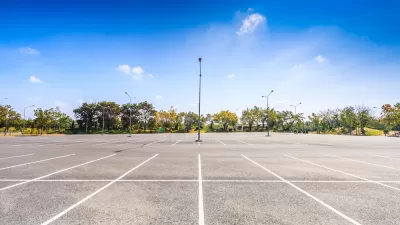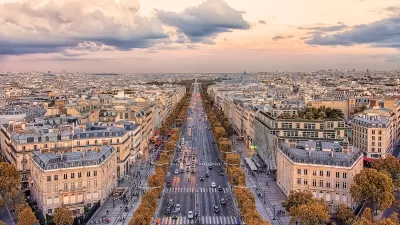As James Howard Kunstler points out in Home From Nowhere, one of the tragedies of single-use zoning is that it branded shopping as an “obnoxious industrial activity that must be kept separate from houses”. Ironically, the places where most Americans shop today come pretty close to “obnoxious” and “industrial”.
As James Howard Kunstler points out in Home From Nowhere, one of the tragedies of single-use zoning is that it branded shopping as an "obnoxious industrial activity that must be kept separate from houses". Ironically, the places where most Americans shop today come pretty close to "obnoxious" and "industrial". Many suburban shopping centers attract hundreds or even thousands of cars per day - a direct result of zoning and parking requirements. In San Diego, Fashion Valley Mall and Transit Center provides 8000 parking spaces. That's a fairly high potential for pollution. Not quite a power plant or a steel mill, but not much more inviting.
Now that development trends are moving toward mixed-use, a common practice in the last decade has been to locate higher density residential housing next to these monstrosities. Take a shopping mall, add residential, and you get an instant walkable "village". And even though they now have people living next door, these malls still attract half the cars in the county.
One of the more poorly-designed retail centers in California, Westfield Mission Valley in San Diego plans a large expansion that will include 250 residential units as well as more retail. In its current form, the congested mall is nearly impenetrable both by car and on foot. Shoppers can expect to park and re-park just to visit a few stores. If history is any guide, expansion would mean placing new retail and residential anywhere it will fit. For example, developers recently located several restaurants in the middle of a Target parking lot near a freeway off-ramp - an impossible setting for pedestrians (see photo). The expansion plan does seek to eliminate sprawling surface parking lots - an encouraging sign - but there is no mention of a major redesign or limiting parking in general.
I'd love to live near a shopping street, but would you want to live next to this?


These aren't the pleasant main streets that Kunstler probably had in mind.
Until developers are willing to part with the big box model, limit parking, and design shopping primarily for transit riders and residents, I'm happy to be zoned away from shopping malls.

Alabama: Trump Terminates Settlements for Black Communities Harmed By Raw Sewage
Trump deemed the landmark civil rights agreement “illegal DEI and environmental justice policy.”

Study: Maui’s Plan to Convert Vacation Rentals to Long-Term Housing Could Cause Nearly $1 Billion Economic Loss
The plan would reduce visitor accommodation by 25% resulting in 1,900 jobs lost.

Why Should We Subsidize Public Transportation?
Many public transit agencies face financial stress due to rising costs, declining fare revenue, and declining subsidies. Transit advocates must provide a strong business case for increasing public transit funding.

Wind Energy on the Rise Despite Federal Policy Reversal
The Trump administration is revoking federal support for renewable energy, but demand for new projects continues unabated.

Passengers Flock to Caltrain After Electrification
The new electric trains are running faster and more reliably, leading to strong ridership growth on the Bay Area rail system.

Texas Churches Rally Behind ‘Yes in God’s Back Yard’ Legislation
Religious leaders want the state to reduce zoning regulations to streamline leasing church-owned land to housing developers.
Urban Design for Planners 1: Software Tools
This six-course series explores essential urban design concepts using open source software and equips planners with the tools they need to participate fully in the urban design process.
Planning for Universal Design
Learn the tools for implementing Universal Design in planning regulations.
Caltrans
Smith Gee Studio
Institute for Housing and Urban Development Studies (IHS)
City of Grandview
Harvard GSD Executive Education
Toledo-Lucas County Plan Commissions
Salt Lake City
NYU Wagner Graduate School of Public Service





























